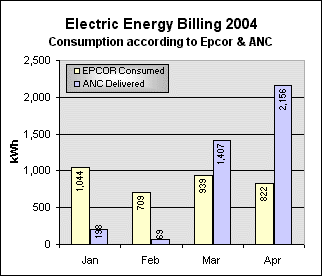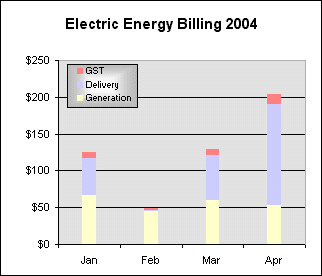| Nobody will blame you if that is the case. Ralph Klein promised that
the deregulation of the energy industry would
provide for a more competitive environment and do all of us good, but what
has happened is that deregulation cost Albertans a lot, an estimated $20
billion and counting over the four years it has been in place.
Roughly half of those extra costs went to the energy corporations.
The rest went to the provincial treasury.
Not all of that money is gravy, of course. A lot of it was used to
pay for the cost of an enormously expanded bureaucracy, both in government
and in the private sector. After all, the deregulation of the energy industry
is a complicated business, and somebody has to pay for it, with nothing
more returned in value than that energy costs increased and a nebulous
promise that eventually we will all be better off on account of that.
The problems created by Ralph Klein's deregulation fiasco are far
from over. At the annual general meeting of the Alberta Federation
of the Rural Electrification Associations (AFREAs) in February 2004, the
Alberta Government identified that no end to the higher energy costs
caused by deregulation is in sight, and that it is hoped that if everyone
just hangs in there and does the right thing, eventually the hoped-for
benefits of deregulation will materialize. The government
representative did not tell that when or if the promised benefits will
eventually arrive is about as certain as that we can convert Alberta
agriculture to produce enough plums to satisfy the demands of the world
market.
Although a few people laughed a bit scornfully and shook their
heads in disbelief when that was stated, the full import of that may hit
home only when the realization sets in that the statement is a self-fulfilling
prophesy. What it means, in essence, is that if the promised
consumer benefits never arise, then it must surely be the fault of someone
or anyone that didn't to the right thing. You see, the ideological
goal is perfect. It's just that people don't measure up to
Ralph Klein's ideological standards.
The energy corporations themselves hardly measure up to the task at
hand. Four years after the fact they still haven't come to terms
with what is required to bill consumers accurately for electric energy
delivered and consumed. Last year it emerged that about 22,000 services (about
8,000 of them REA members) in the Aquila service area had not been billed
for any of the electric energy they consumed since January 2001.
Retroactive billing can be done only for one year back. What will
happen to the cost of the energy that nobody got or can be billed for?
Well, you and I already covered that little bit, through the cost of
unidentified energy that is being incorporated in the price for energy
that people do get billed for, and most likely some of that energy will be
paid for twice over, to boot.
But that was not all. Aquila services that are being billed
 through EPCOR
also had not been billed for more than six months for the recovery of the
debts that those services had racked up when Ralph Klein had forced them to rack
up that debt by putting an 11¢/kWh "price
ceiling" on electric energy consumed during 2001, when the real price of
electric energy delivered to end consumers had more than tripled over
night to 18¢/kWh and many
Albertans with fixed incomes in the low-income range found themselves
unable to pay their electric energy bills. through EPCOR
also had not been billed for more than six months for the recovery of the
debts that those services had racked up when Ralph Klein had forced them to rack
up that debt by putting an 11¢/kWh "price
ceiling" on electric energy consumed during 2001, when the real price of
electric energy delivered to end consumers had more than tripled over
night to 18¢/kWh and many
Albertans with fixed incomes in the low-income range found themselves
unable to pay their electric energy bills.
The "price ceiling" was no such thing. It was a hidden,
cumulative debt that consumers were forced to rack up for energy consumed
during 2001; that consumers are still paying back right now and will
continue to pay for until December of 2004.
However, as the two graphs shown in this article identify, the
billing problems that arose from deregulation are far from over.
It boggles the mind to imagine what could possibly have happened to
data on energy consumption for individual services on the way to producing
bills for energy consumed by those services. How could it possibly have
happened that energy consumption data from a common source, consumption
read at the meters, resulted in consumers being billed for two different
amounts of energy, one for one amount of energy consumed, and one for
another amount of energy delivered.
In case the people that produced the bills containing the conflicting
numbers for energy delivered and consumed in each
 month
billed during 2004 don't know, they should have known. Energy
consumed cannot differ from energy delivered. Energy consumed can
neither fall short of nor exceed energy delivered. If the two
numbers don't match exactly, something is seriously amiss. month
billed during 2004 don't know, they should have known. Energy
consumed cannot differ from energy delivered. Energy consumed can
neither fall short of nor exceed energy delivered. If the two
numbers don't match exactly, something is seriously amiss.
Of course, the confusing puzzle is carried over to what consumers
are expected to pay, which is: confusing and varying monthly amounts of money
that it is impossible to reconcile with the information provided on the
bills identifying amounts of money that fluctuate wildly from month to
month.
EPCOR, which does the billing for some of the REAs in the Aquila
service area, finally provided an explanation of the puzzle with their
bill for April 2004 that points the finger of blame squarely at Aquila:
We have resolved some difficulties we had
in processing the delivery charges we receive from your Wire Services
Provider. Unfortunately these difficulties resulted in a delay in
applying these charges to your EPCOR statement. (EPCOR's letter to Dear
Sir/Madam, dated April 2004, an enclosure in EPCOR's electric energy bill for
Apr. 2004)
Nevertheless, one could imagine that, as
happened on the February 2004 bills that EPCOR produced, if credits for
March are applied to the February bill that result in reducing the amount
of energy delivered in February to next to nothing, that alarm bells
should have gone off and clanged loudly in the EPCOR Billing Department.
Although EPCOR and Aquila both take in vastly greater amounts of money
from consumers of their services than they did before deregulation came
into effect, apparently not enough of that money is being devoted to quality control.
It's either that, or even in the electric utility corporations there is by
now no-one left that still understands what needs to be done to produce
accurate and confidence-inspiring electric energy bills.
One thing is certain and an absolute reality. The average monthly
amount billed for January through April 2004 (prior to
"deregulation") for the service reflected in the two graphs shown in this
article was a total of $68.22 for the same amount of electric energy
delivered and consumed. The current average monthly total for
the same service is $126.44. That is an increase of 85 percent in
the cost of electric services due to the alleged and non-existent benefits
of deregulation. That is money that came directly out of my pocket
and out of those of any other consumers of electric energy.
In addition there are the subsidies that Ralph Klein so
generously provided to ease the shock of deregulation, money that came out
of taxpayer-provided revenues.
Thank you very much Mr. Klein. We'll
keep in mind what all we could have done with $20
billion that went down the drain, and what all had to be cut back to come
up with that kind of money, a total of about $5,700 for every man, woman
and child in Alberta. It appears that with that sort of people around to effect transfer payments to the utility corporations, we hardly
need them to make net transfer payments to the federal
government — to the tune of about $9 billion/year — for which we receive nothing in return either.
____________________
The MS Excel Spreadsheet (28kB) from
which the two graphs shown in this article were constructed. |



